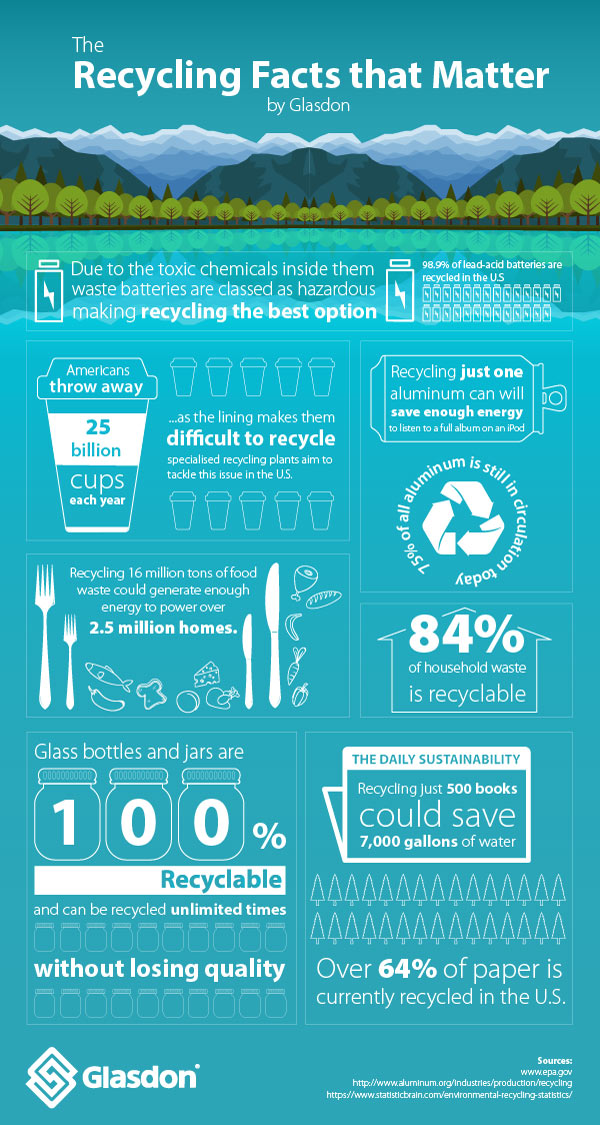Did you know that every year Americans generate around 258 million tons of trash?
And yet the recycling rate of this Municipal Solid Waste (MSW) in the United States is a mere 34.6%, resulting in at least 169 million tons of waste ending up in landfills and incinerators!
Go Compare...
- Over 84% of all household waste in the States is recyclable
- Maine was ranked #1 for recycling the most MSW in 2017
So, how can we work together to improve recycling overall?
What does recyclable waste look like?
In this infographic, we explore the facts and the stats behind some of the most common types of recyclable products and materials.

You can also download the infographic for free here.
Aluminum
Aluminum is one of the most commonly used metals in the world and is popular for packaging items such as drinks cans. Every year Americans throw away nearly $1 billion worth of aluminum cans.
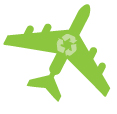
- More than 90% of energy is conserved when recycling aluminum over producing new metal
- Recycling one aluminum can will save enough energy to listen to a full album on an iPod
- An aluminum drinks can contains 4 different alloys – the body, can end, ring pull and the rivet in the ring pull!
- Nearly 75% of all aluminum produced in the U.S. is still in use today
- Recycling just one ton of aluminum conserves over 152 million Btu – the equivalent of 21 barrels of oil
Plastic
Over 33 million tons of plastic waste are generated yearly in the States, of which only 9.5% are recycled.

Due to its composition, plastic can take up to 1,000 years to decompose in landfill, and so it’s important that we all do our part to recycle plastic.
- 11% of all household waste is plastic
- Plastic bottles are the most commonly recycled plastic in the U.S.
- Just 15% of plastic containers and packaging are recycled
- The amount of plastic floating in the ocean is the equivalent of 46,000 pieces for every square mile
- 2.5 million plastic bottles are binned by Americans every hour
Read our FAQ on minimizing plastic waste to find out how you can help reduce the amount of plastic sent to landfill.
Batteries
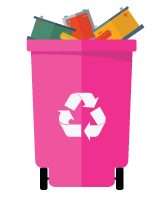
Batteries often contain heavy metals such as lead, zinc or mercury which are considered hazardous to the environment when improperly disposed of.
- Americans purchase nearly three billion dry cell batteries every year
- Up to 99 million lead-acid batteries are manufactured annually
There are many benefits of battery recycling, including the conservation of natural resources and pollution prevention. In the U.S, the recycling rate for lead-acid batteries is an impressive 98.9%, with 2.81 million tons being diverted from landfill annually.
Food Waste
Did you know that about 95% of food that could be composted ends up in landfills and incinerators?
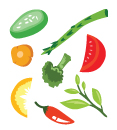
Recycling food waste into compost helps to enrich soil, retaining moisture and suppressing plant diseases and pests.
- The rate of food composting is currently at 5.1% per year (1.94 million tons)
- There are two types of food waste recycling – anaerobic digestion & in-vessel composting
- Recycling 16 million tons of food waste using anaerobic digestion could generate enough power to serve more than 2.5 million homes annually
Our best practices guide to reducing commercial food waste explains how you can help prevent, recover and recycle food waste.
Paper Cups
Annually, 25 billion cups are sent to landfill in the U.S, generating 363 million pounds of waste.

Because of their intended use paper cups have to be lined with a soft plastic or wax. This means the cup needs to be separated from the lining to be correctly recycled.
There are specialist plants where these cups can be broken down, however they aren’t yet widely used. Increasing the collection of paper cups in the first place is a step towards helping to improve cup recycling.
Have a look at our guide on how to be a sustainable coffee server for more information about how you can improve cup collection and recycling.
Glass
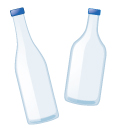
Glass is 100% recyclable and can be re-used and recycled multiple times without losing purity or quality. Despite this, only 32.5% of glass containers are recycled in the U.S.
Once in landfill, glass will never decompose. This can put a strain on landfill sites which receive a lot of glass, that could otherwise be recycled.
- Recycled glass can be substituted for up to 95% of raw materials
- For every ton of glass recycled, a ton of natural resources are saved
- States with container deposit laws have an average glass recycling rate of over 63%, compared to an average of 24% in non-deposit states
Waste Paper & Magazines

Paper is one of the largest components of MSW and currently nearly two thirds of all waste paper is recycled. However, unlike glass, paper recovery isn’t endless and eventually the fibers become too weak to be reused.
- Every ton of paper recycled can save the equivalent of 322 gallons of gasoline
- Paper and paperboard accounts for over 26% of the total MSW generated
- 4 billion trees are cut down each year for paper use
- Paper fibers can be recycled on average 5-7 times
- Recycling just 500 books could save 7,000 gallons of water
- Paper recycling makes up 50% of the total MSW recycled annually
Foam
Polystyrene is commonly used for food containers and service products.
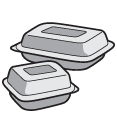
Due to recycling constraints, polystyrene is not widely accepted in curbside recycling programs, but can often by recycled at designated collection centers.
- Foam food containers make up less than 1% of landfill waste
- 63 million pounds of expanded polystyrene (EPS) were recycled in 2016
- Polystyrene does not biodegrade, but is a recyclable #6 thermoplastic
- Every year, America uses enough EPS to circle the world 426 times
More and more states are implementing foam recycling events and programs in order to tackle this waste stream. To find your nearest foam recycling drop off point, visit Earth911.
Don't forget to check your local recycling rules before placing your items into a trash can!
For more information on the benefits of recycling, please feel free to browse our website or contact us today!
Sources:https://www.epa.gov
https://wallethub.com/edu/greenest-states/11987/
http://www.aluminum.org/industries/production/recycling
http://northstarrecycling.com/food-waste-recycling-facts/
http://www.gpi.org/recycling/glass-recycling-facts
http://wastefreemail.com/faq.html
https://www.foamfacts.com/faq/
https://www.statisticbrain.com

